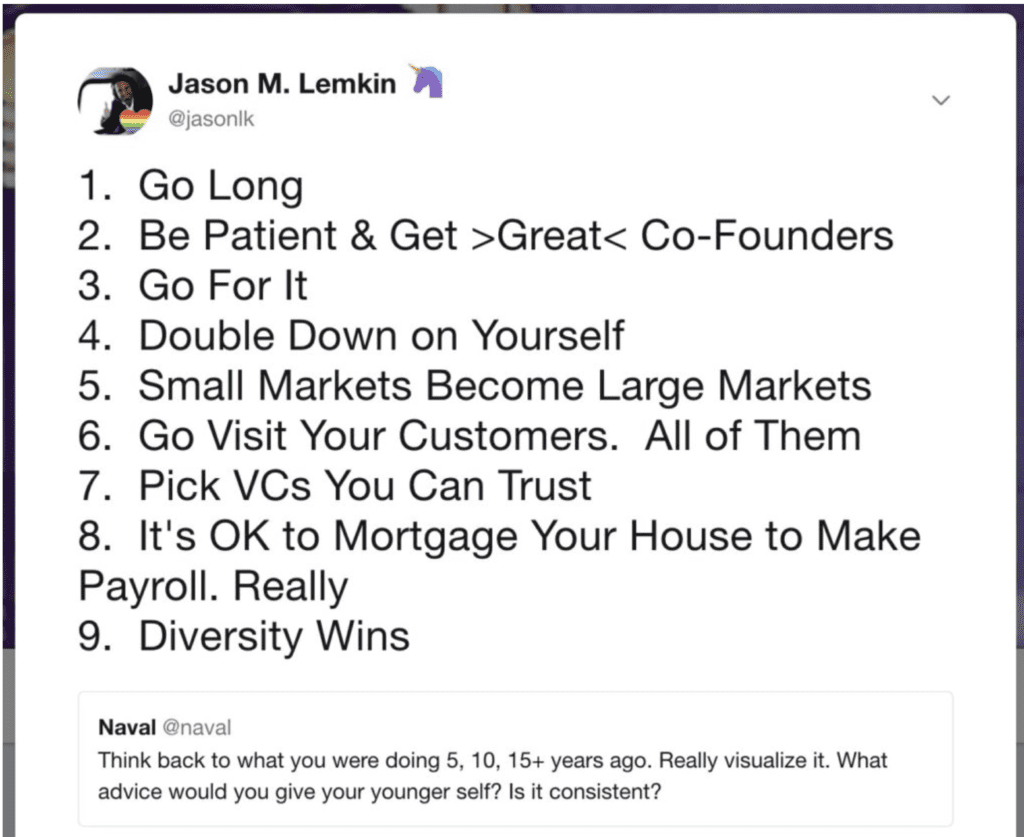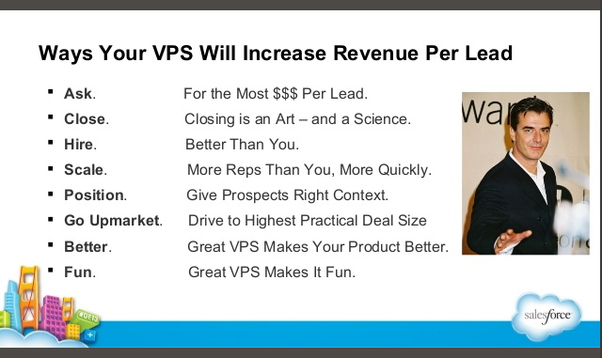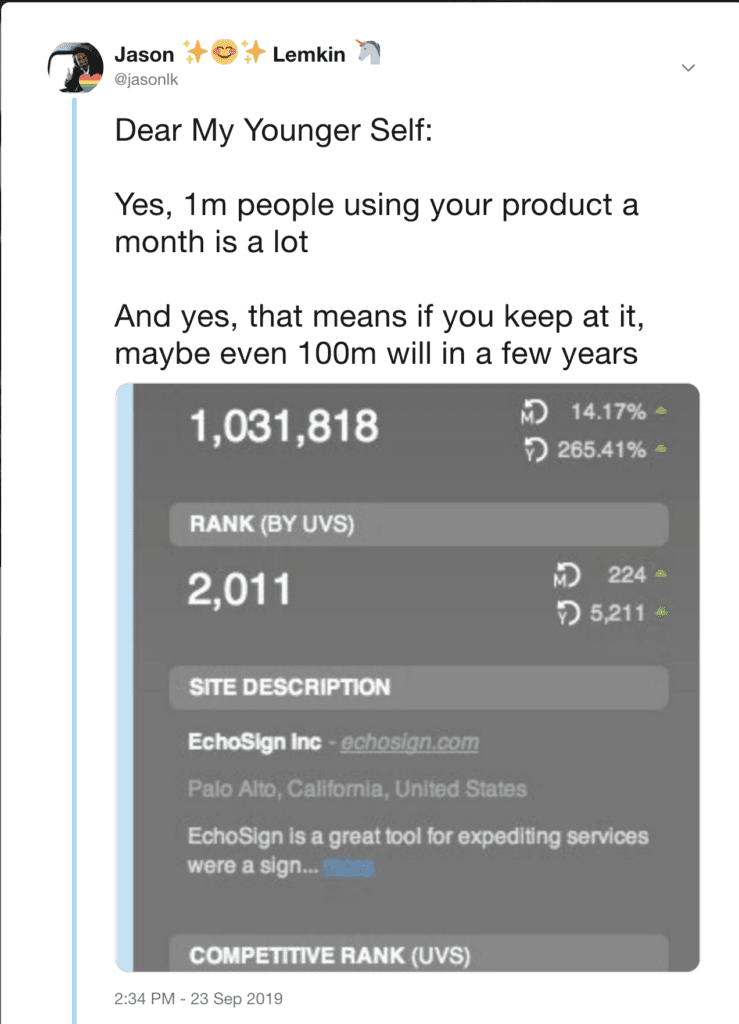A ways back, a Naval post on Twitter had me reflecting on the top advice I’d give to my younger CEO self:

I missed one of the key Top 10 points — (I ran out of 240 characters on Twitter), but thought it might be worth breaking them down in more detail on SaaStr below:
1. Go Long.
This can be hard. The first start-up I ever joined as an employee was quickly acquired for $200m, which became $1 billion (!) by the time the deal closed, we IPO’d … and then our acquirer went bankrupt. Poof. I lost $12,000,000 on paper in 12 months, and it went to $0. Boy, that was hard. To lose it all.
It was tough to recover from that. And even harder to think about Going Long. Instead, it sort of makes you think about taking the First Good Offer for your startup. Which is the logical choice.
But I’ve learned a lot since then, especially in SaaS. If you can get to $10m in ARR, growing 80-100% or more Year-over-Year, and have happy customers AND a good team … if … then you can’t be stopped. You can get to $20m, then $40m, then $100m in ARR. Go Long — if you get to Initial Scale with happy customers and good growth. Power Laws are real.
2. Be Patient and Get >Great< Co-Founders.
I’ve been both patient and impatient with co-founders (and VPs). Whenever I was too impatient, it’s always been a mistake. Especially with co-founders. When I’ve had amazing co-founders and we were 100% aligned in values and drive (and complementary in skills) … we were always unstoppable. In fact, we were able to do the impossible. But when I had co-founders that were individually strong but we weren’t aligned … it was just too hard. You can’t wait for perfect. But give your “get it off the ground” phase an extra few months to find a truly great co-founder. And one you truly trust.
3. Go For It.
Both in starting something new, or just a new big initiative, anything big … well, carefully collect data. Interview at least 20 potential customers. Build a thoughtful model. But when after that you know you should do it — just do it. You will only have so many chances to found something great, join something great, do something great. There are 1000s of startups but only a handful of great opportunities for most of it. Don’t let them go.
4. Double Down on Yourself.
This one took me a little while to figure out (thanks to Auren Hoffman for helping me see this clearly), but if you’re a founder, the best investment you can make is in yourself. I’ll never make more money in the stock market, or investing in startups, or anything else … than I’ve made betting on myself.
When things were really rough at EchoSign, I stopped taking a salary for 18 months. But as part of the deal with the VCs, I took stock instead. I made an effective 12x on that stock. That’s better than the 0.2% you make on bank interest.
Everything related to SaaStr I’ve self-funded, from the SaaStr Annual to SaaStr Pro to the CoSelling Space to our entire amazing management team. And I put in a very large capital commitment into investing. This is stressful a lot of times. Scary a few times. But if you can build something of value … it’s hard to make more money otherwise.
5. Small Markets Become Large Markets.
Many people will tell you your market is too small. Well, of course it is — today. You are either doing something new, or changing something. Salesforce is on track to $20 billion in revenue and closing in on a $100b market cap. This is far larger than the entire CRM market was when Salesforce was founded.
Yes, markets today are small. But some of them grow as they mature. And other markets, the best founders like Benioff, Jobs, Gates, Zuck, etc. redefined markets. You can do it that way, too. Add 10-100x more value to a market than existing before, and the market size can grow 10-1000x, too.
When we started EchoSign / Adobe Sign in 2005/2006, the web-based e-signature market was $1m in market size. Today, it’s coming up on $2b in revenues. That’s 2000x growth.
TAM is what you make of it.
6. Go Visit Your Customers. All of Them.
This was a lesson I learned in my first startup, but then kind of forgot with EchoSign. In my first start-up, it was all 7-figure deals. So of course you go visit the customers. 🙂
But then EchoSign was my first experience with 100s and 1000s of customers. I didn’t visit hardly any of them. That was a huge mistake.
When times were really tough, I met with one of my ex-bosses and mentors, Mark Selcow (founder Merced Systems + BabyCenter, now GP at Costanoa Venture). I explained all the Woe is Me challenges I was having.
“Get on a jet”, he said. (Mark is one of the most talented natural sales leaders I know). “Go visit your customers and prospects.”
I didn’t know if it would help, but I didn’t have a better idea.
It was magic.
I never lost a customer I personally visited. And they bought more from us. A lot more. And more deals closed, including Google. It was magic. And it was that simple.
7. Pick VCs You Can Trust.
As a founder, in fact, I pitched 150+ VC firms and took money from a half dozen or more. But I only truly trusted one of my investors (thank you Jason Green / Emergence Capital).
(There are more I trust now having co-invested with them, and many of them are my LPs. See here.)
But what does trust mean in a VC context? It means you are free to do what is right for the company. Without looking over your shoulder. Without worrying where you stand. Not wondering who they might bring in to help “run” the company. And knowing if they will put more money in — and also knowing if they won’t (that’s OK too, you just need to know). VCs have many incentives to be guarded here. This doesn’t help you.
Venture capital is incredibly important, and for many of us, a huge enabler of success. I would have nothing without it.
But forget all the rest of reasons to pick a VC. Forget the value-add, and the intros, and the Rolodexes, and the brand, and the cool office in South Park.
All money is green, get the deal done. But — if you have options, pick a VC you can trust. And if that means taking your time to know for sure … like a co-founder … take your time.
Even if that means letting an exploding term sheet go. Even if it means asking to take that extra meeting, and putting the deal at risk. Even if it means a lower valuation, or less of a brand.
8. It’s OK to Mortgage Your House to Make Payroll. It Really Is.
When I was trying to get my first start-up off the ground, I lost a term sheet and had to make payroll. A new investor syndicate came in, but as part of the conditions in the terms, I had to personally guarantee $750,000 and the next payroll (I know this sounds crazy, I’ll skip the details here on why that was the case).
Now my life savings at this point was like $15,000 … but we did have a house. I signed the full-recourse note, without telling my wife. Because it was too insane.
But it had to be done, and it worked. We made payroll, we got funded, and we sold the company for $50,000,000 12.5 months later.
Startups are hard. Really, really hard. Hard in a way employees, and VPs, and non-founders will never understand. You may have to mortgage the house. That may be crazy. But if your gut tells you you need to do it — do it.
9. Diversity Is So Important. Diversity Wins. My first start-up was the most diverse environment I’ve been in. 2/3 of the co-founders were women, and 8/10 of the first 10 employees were from multicultural backgrounds. Vietnam, India, Pakistan, Mexico, everywhere. Infinite diversity really does lead to infinite combinations.
I then moved to environments that were less diverse. I still did OK. But looking back, that lack of diversity was probably the biggest impediment to not doing even better. It was especially rough working in venture capital. It felt like stepping back in time 20 years.
We are working hard to make SaaStr as diverse an environment as possible.
10. After You Hit Initial Traction — Drop Almost Everything and Hire the VPs. Finally, at a more tactical level, the #1 bit of advice I’d give to my younger CEO is once you hit initial traction — drop almost everything and hire great VPs. I was always good at assembling a strong initial team, and doing the impossible. But three times now, I’ve run out of gas approaching $10m in revenue. I’ve gotten behind on hiring the VPs you really need to scale. Twice, I sold because of it. The third time, I was driven to the brink of total exhaustion.
Miss a quarter if you have to. Skip a release. But try to hire all the VPs (Sales, Marketing, Product, Engineering, Success) by $8m-$10m in ARR at least. And at least 1 or 2 by $2m in ARR. Otherwise, you’ll run out of steam just as it gets good. You really can’t do it all yourself.

Good luck. And if you have something good — just remember, It Compounds.


